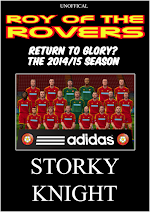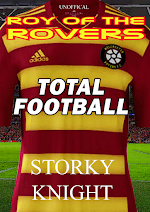Melchester Rovers fans will be familiar with their red and yellow shirts, but how many knew that Rovers originally played in mauve? I've seen a few attempts made to document the kit history of the great club, but none have really come close to giving a complete timeline.
Melchester Rovers were formed in 1885 by workers at the Crib Lane Freight Company. They chose a delightful shade of mauve for their first jerseys. These were worn until the end of Rovers first season in the Football League, when the permanent switch to red and yellow shirts occurred.
For most of the 1900s Rovers would wear their most famous design - red shirts with yellow sleeves. However, two other designs were sported during the decade. Around 1900-1902 Rovers would first wear red and yellow striped jerseys, probably with white shorts, which were the preferred choice at the time. That striped design would next be used in 1991/92 in one of Rovers most popular shirts.
The 1907 FA Cup winning side also wore a design familiar to long term Rovers fans. In 1973 when Rovers switched to their ultramodern strip, a number of players believed the new kit to be cursed. However, Penny Laine (later Race) scanned the club archives to discover that the shirts worn by Rovers' first cup winning XI were very similar, with the side stripe just slightly wider!
After 1910 Rovers made the switch to a design that would last with very few changes and exceptions until the late 1950s - the famous red shirts, golden yellow sleeves, navy shorts with smart red socks, trimmed with yellow and red.
The early years of the Rovers also saw the club turn out in some exceptional strips. It is believed that Rovers first wore their famous design during a spell in the Southern League. However, the source for this is unreliable, a memory from an elderly fan and the years he gives (1902) don't fit, as Rovers were already in the Football League by then.
Some images also exist of the Rovers playing in a round neck design popular at the time, while also wearing socks with a very dark trim. This strip can be dated to sometime between 1902 and 1904. However, sources suggest that the combination was rarely worn.
In about 1905/06 it is known that a fire gutted the Rovers ground at Reckton Park, destroying the players' kit and boots. Rovers rebuilt the grandstand and played on in borrowed kit. It is assumed that Rovers would be required to maintain a red shirt, to meet league rules, but the only images show a much darker shade and black socks.
After a sudden decline in the 1920s, the golden years of the Rovers came during the 1930s. Manager/trainer Jimmy Leathers led the club back to the First division, when the legendary boss George Armstrong would lead Rovers on a trophy spree, with 3 League titles and 4 FA Cup Finals! Rovers dropped the yellow sleeves for sometime during the 20s and early 30s. Before returning to the classic design in the mid-30s, which would remain the dominant choice until the mid-50s. The smart all red jersey was worn by Albert Woodall and Dandy Richards, stars of the Rovers team in the 20s and 30s. Rovers wore the traditional outfit in the 1936 FA Cup Final, when skipper Ben Galloway lifted the famous trophy.
One error often made by archivists is to include Roy's youth club red and yellow hooped design as a Melchester Rovers kit. Rovers did not wear hooped jerseys until 1981. Rovers nearly always wore their familiar red and golden yellow sleeved shirts, with long navy shorts. With just the collars changing throughout the 50s. The neat v-neck first appeared on the summer tour to La Ventura in 1955. When Roy made his league debut in 1955, a traditional button up collar was worn. In 1956, that collar was replaced with a triangular stretch collar, which Rovers would wear for two years, including skipper Andy McDonald's final season 1957/58 when Rovers won the league title, their first trophy since the 1948 Double winning season. The v-neck would return in the summer of 1958 and remain a feature for some years to come.
In 1959 Rovers wore a special FA Cup Final kit, with badge and nice red trim added to the top of the socks. The smart kit would prove lucky as Rovers defeat Langton United to win the Cup! The badge was dropped, but the red trimmed socks remain for the 1959-60 season. Mid-way through the 1959/60 season Rovers would again drop the yellow sleeves, wearing a very smart all red jersey. The rest of the strip would remain unchanged. However, at the halfway point of the 1961/62 season, Rovers would revert back to the 1959/60 shirt and yellow sleeves were back and Rovers would go on to win the title again!
The summer tour to the USA in 1961 saw Rovers wear one of the most striking kits. The team's kits and boots were stolen, leaving Roy and the boys to scrounge kit from a local university. The result, worn just once versus Cragville College was in traditional Rovers colours but featuring a brilliant yellow cross and bright blue shorts.
Part 2 will cover 1965 to 1981 and be published next week.
If there are any questions use the comments below.
NOTE - the dates for anything before 1954 are calculated using various sources. Some information in the comics and stories over the years is contradictory, but I use the most reliable sources to form the most logical timeline. Some sources are more reliable than others, for example, the early years striped jersey is shown only in a framed picture on the wall of the trophy room. The year is estimated using trends in kit design.
The kits template is copyright Historical Football Kits


















0 Comments